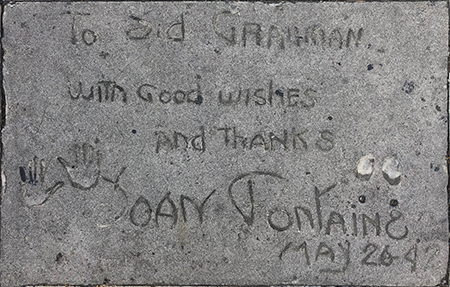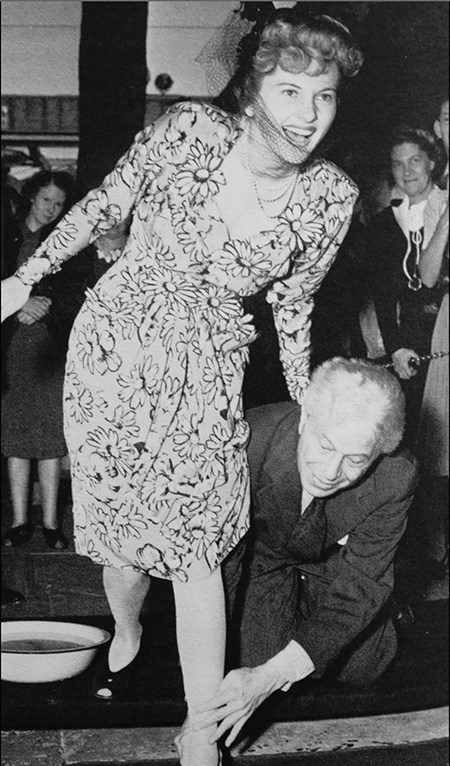 |
 |
|
|
| Joan Fontaine |
 |
| Forecourt Ceremony held on Tuesday, May 26, 1942 |
| |
Born: Joan de Beauvoir de Havilland, October 22, 1917, in Tokyo, Japan
Age at the time of the ceremony: 24
Died: December 15, 2013, in Carmel Heights, California, age 96 |
| |
Joan Fontaine rocketed to fame as the heroine of Rebecca, thereafter entering into the ranks of leading ladies of the 1940s. She had tremendous technique; many directors and producers wanted what she could bring to a film.
Born to British parents working in Tokyo Japan, Joan's mother had been an actress on the stage. Her parents separated in 1919. Worried for younger daughter Joan's health, Lillian moved her and older daughter Olivia to Saratoga California, where Joan's health improved. She and Olivia began taking acting and diction lessons, but when Joan was 16 years old, she decided that she wanted to live with her father in Tokyo, where she remained until 1935.
Returning to the United States, Joan made her stage debut in the play Call It a Day, written by Dodie Smith. She was signed to a contract at R-K-O, making her screen debut on loanout to M-G-M in No More Ladies (which played the Chinese in June 1935), billed as Joan Burfield — mother Lillian insisted that only sister Olivia be allowed to use the de Havilland name. Joan eventually settled on Fontaine.
R-K-O shoved her into a number of films at the studio and on loanout, but somehow, none of the pictures supported her personality: A Million to One (released in March 1937), and Quality Street (released in March 1937). She was even given the romantic lead in the Fred Astaire musical A Damsel in Distress (released in November 1937), but Fred without Ginger Rogers — the picture flopped. She was even in Gunga Din (released in February 1939), making her third picture for director George Stevens. She may be seen in George Cukor's masterpeice The Women (which had its world premiere at the Chinese in August 1939).
Fontaine found herself at a dinner, sitting next to producer David O. Selznick, who asked her to audition for the lead in the film he was making of the novel Rebecca (which would be released in April 1940). After much auditioning, she got the part. Finally, a film which took advantage of Fontaine's expressive and pschologically informed talent. The film was a monster hit, making Joan Fontaine a household name.
Director Alfred Hithcock was so impressed with Fontaine that he cast her opposite Cary Grant in his next film, Suspicion (released in November 1941). Fontaine was nominated and won the Oscar for Best Actress for this film over her sister Olivia, increasing a rift between the siblings (which apparently, never healed).
After this, Fontaine became a freelancer, switching to Warner Bros. for The Constant Nymph (released in June 1943), and to 20th Century-Fox to play the lead in Jane Eyre (which played the Chinese in February 1944), then to Universal for Ivy (released in June 1947), and to Universal again for Letter from an Unknown Woman (released in April 1948).
Fontaine starred with Bing Crosby in director Billy Wilder's odd musical The Emperor Waltz (released in July 1948), which was a huge hit anyway, and
Ivanhoe (released in February 1953). Fontaine joined the cast of the CinemaScope travelogue Island in the Sun (which played the Chinese in June 1957).
In the 1950s Fontaine turned to the stage and to television, receiving good notices for her role (taking over for Deborah Kerr) in Tea and Sympathy on Broadway in 1954. She appeared on many television programs, including Four Star Playhouse in 1953 and 1955, General Electric Theatre in 1956, 1957, 1958, 1960 and 1961, The Dick Powell Theatre in 1962, Wagon Train in 1963, The Alfred Hitchcock Hour in 1963, The Bing Crosby Show in 1965, Ryan's Hope in 1980, The Love Boat in 1981, Hotel in 1986, and so on.
Fontaine retired to her Villa Fontaine in the Carmel Heights, where she enjoyed her garden and her pet dogs. She died of natural causes at home, at the age of 96. |
|
|
|
|
| |
 |
 |
| Grauman's Chinese Theatre, Hollywood, California. Joan Fontain Forecourt block. Executed by Jean Klossner, Tuesday, May 26, 1942. 58 x 39 inches. |
 |
 |
 |
| Grauman's Chinese Theatre, Hollywood, California. Joan Fontaine Forecourt ceremony, Tuesday, May 26, 1942. Joan Fontaine leans on Sid Grauman as he helps her make her foot imprint. |
|
|